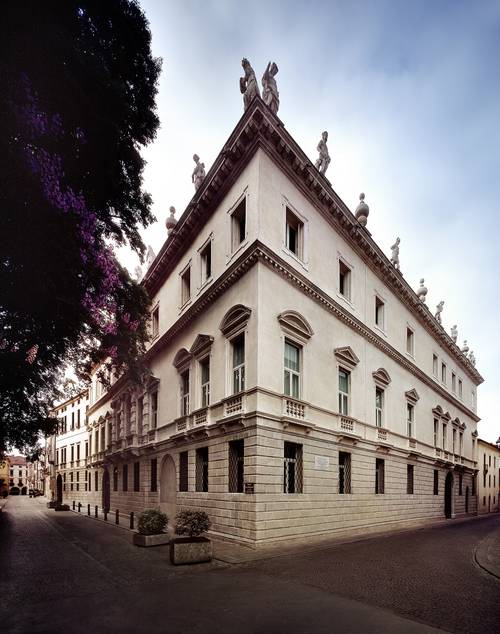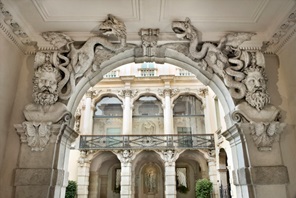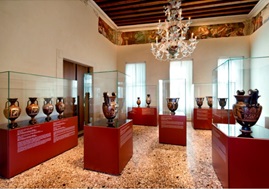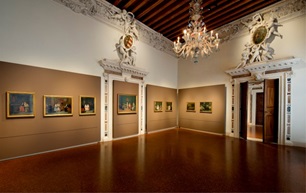The Theatre City: discovering the Jewels of Vicenza on Foot
Vicenza, Palladio’s home town, with its 114,000 inhabitants lies in the heart of the Veneto. Vicenza is inextricably linked to Andrea Palladio and visiting Vicenza means a tour through the history of architecture, from Romanesque to Gothic to Renaissance to Neoclassical. In 1994 Vicenza was declared a UNESCO World Heritage Site, with 26 Palladian structures in the city and a further 16 Palladian villas in the surrounding area. Aside from the Palladian jewels, there are also dozen artistic masterpieces in the churches and buildings dotted through the city, which over the centuries has collected significant works by great artists such as Tiepolo, Veronese, Canova and Maganza.
Visit to Gallerie d’Italia – Palazzo Leoni Montanari, Intesa Sanpaolo’s cultural venue and museum in Vicenza.

Palazzo Leoni Montanari | © 2016 diritti riservati Intesa Sanpaolo. Immagini tratte dall’Archivio Attività Culturali di Intesa Sanpaolo
This seventeenth-century palazzo, located in the historical city centre, features magnificently decorated and much-celebrated scenographic interiors – Palazzo Leoni Montanari is in fact the only markedly Baroque residence in the city of Palladio.

Palazzo Leoni Montanari | © 2016 diritti riservati Intesa Sanpaolo. Immagini tratte dall’Archivio Attività Culturali di Intesa Sanpaolo.
The Gallerie permanently display three of the banks’ art collections: the piano nobile is devoted to temporary exhibits of different nucleuses of beautifully painted vases selected from the remarkable Attic and Magna-Graecia pottery collection.

The collection of Attic and Magna Grecian ceramics | © 2016 diritti riservati Intesa Sanpaolo. Immagini tratte dall’Archivio Attività Culturali di Intesa Sanpaolo.
On the same floor eighteenth-century Veneto art ranges from Pietro Longhi’s ironic costume paintings to the airy vedutas depicting Venice and other cities’ natural and architectural wonders.

The collection of eighteenth-century painting | © 2016 diritti riservati Intesa Sanpaolo. Immagini tratte dall’Archivio Attività Culturali di Intesa Sanpaolo.
The first floor also boasts Fall of the Rebel Angels, a truly magnificent pyramid composition of sixty small figures sculpted out of a single block of Carrara marble, crafted in the mid-eighteenth century by Agostino Fasolato.

Agostino Fasolato (Padova 1714 – post 1787) La caduta degli angeli ribelli, 1750 ca, marmo di Carrara, 168 x 80 x 81 cm | © 2016 diritti riservati Intesa Sanpaolo. Immagini tratte dall’Archivio Attività Culturali di Intesa Sanpaolo.
Lastly, the top floor is devoted to Russian icons, that with their striking colours and meticulous respect for ancient models, take viewers on a historical, artistic, and spiritual journey.
![]()
The collection of Russian icons | © 2016 diritti riservati Intesa Sanpaolo. Immagini tratte dall’Archivio Attività Culturali di Intesa Sanpaolo
Detailed programme
10:00
Arrival in Vicenza after a Milan–Vicenza bus transfer. Meeting with the tour guides that will accompany the group the whole day.
10:00–12:00
Walk around the most interesting streets and squares of Vicenza’s historical centre.
Visit to the Church of Santa Corona, a beautiful Gothic church founded by the Dominicans, home to many important sculptures and paintings, including Giovanni Bellini’s masterpiece The Baptism of Christ, and works by Bartolomeo Montagna, Paolo Veronese, and Giambattista Pittoni.
Visit to Gallerie d’Italia – Palazzo Leoni Montanari, Intesa Sanpaolo’s cultural venue and museum in Vicenza.
This seventeenth-century palazzo, located in the historical city centre, features magnificently decorated and much-celebrated scenographic interiors – Palazzo Leoni Montanari is in fact the only markedly Baroque residence in the city of Palladio. The Gallerie permanently display three of the banks’ art collections: the piano nobile is devoted to temporary exhibits of different nucleuses of beautifully painted vases selected from the remarkable Attic and Magna-Graecia pottery collection; on the same floor eighteenth-century Veneto art ranges from Pietro Longhi’s ironic costume paintings to the airy vedutas depicting Venice and other cities’ natural and architectural wonders; the first floor also boasts Fall of the Rebel Angels, a truly magnificent pyramid composition of sixty small figures sculpted out of a single block of Carrara marble, crafted in the mid-eighteenth century by Agostino Fasolato; lastly, the top floor is devoted to Russian icons, that with their striking colours and meticulous respect for ancient models, take viewers on a historical, artistic, and spiritual journey.
13:00–14:00
Light lunch at Gallerie d’Italia – Palazzo Leoni Montanari
14:00–17:00
Visit to the Teatro Olimpico, absolute high point of Andrea Palladio’s creativity, inaugurated in 1585 and considered the world’s first indoor theatre inspired by those of ancient Greece and Rome.
Part of the theatre are also Vincenzo Scamozzi’s famous perspective stage sets representing the streets of Thebes.
Visit to the Civic Art Gallery of Palazzo Chiericati, architectural masterpiece dating to Palladio’s early maturity, aristocratic residence during the sixteenth and seventeenth century, and today’s Vicenza civic gallery holding painting, sculpture, and applied arts collections from the thirteenth to the nineteenth century.
Visit to the Palladio Museum, located in Palazzo Barbarano, one of the most beautiful urban residences designed by Palladio. Visitors will then be accompanied on an exciting journey to discover his life and his age, viewing the masterpieces this extraordinary architect left in Veneto.
Visit to the Basilica Palladiana, Vicenza’s most iconic architecture, part of the UNESCO world heritage. Most notable is Andrea Palladio’s design of the Basilica’s double order of loggias and of the dome, shaped as an upturned-hull of a ship.
17.30
Guests are accompanied back to the bus that will drive them back to Milan.